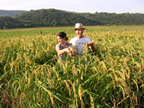BRAZIL
[en español]
Progress and Activities
-
Research by Christoph Gehring Show Mixed Results for
SRI in Amazonia
Two papers by Chrisoph Gehring about his 2007-2008 experiments with the System of Rice Intensification in Amazonia have shown that SRI practices shown mixed results. The most recent article, published in 2012 (Ecological intensification of rice production in the lowlands of Amazonia – Options for smallholder rice producers) ultimately found that grain production was higher in conventional irrigated rice, but pre-grain-filling performance was better in SRI. Aerobic water regime and organic fertilizers, however, reportedly did not perform as well as continuous flooding and synthetic N. The paper ultimately concludes however, that low-density transplanting recommended by SRI out-performed direct-seeding and is worthwhile for smallholder agriculture.
An earlier paper by Christoph Gehring and colleagues was presented at the 2008 Conference on Tropical and Subtropical Agricultural and Natural Resource Management (TROPENTAG) in Hohenheim, Germany, reported on research at an Embrapa research station in Arari county, Maranhão State, in the southeastern periphery of Amazonia. The paper, System of Rice Intensification (SRI) in southeastern lowlands of Amazonia – a viable alternative for smallholder irrigated rice production?, compares key rice plant development parameters between SRI and conventional rice management at two levels of N-fertilization.
While plant biomass, 1000 grain weight and rice production was slightly higher in conventional than in SRI treatments (4.4 vs 3.7 t/ha grains with manure and 6.2 vs 5.7 t/ha grains with manure + urea application), SRI did demonstrate its potential as management alternative, with a more vigorous root system and larger root biomass, with larger panicles, and with the lower plant density nearly compensated by the strong increase of the number of shoots per plant. The authors therefore felt that the slightly lower productivity of SRI confirms its potential as a promising management alternative. Future research was reportedly planned to investigate (i) altered nutrient dynamics under SRI conditions, (ii) the potential of SRI in other soils, (iii) the danger
 of greenhouse gas emissions associated with SRI, and (iv) better
adapt SRI management to the local context. However, we do not whether these investigations were carried out.
of greenhouse gas emissions associated with SRI, and (iv) better
adapt SRI management to the local context. However, we do not whether these investigations were carried out. -
Farmer Validates SRI Methods in State of Rio Grande do Sul
In July 2007, Andre Goncalves, while on leave from the Centro Ecologico to undertake a PhD in Natural Resources for Cornell University, introduced SRI methods to a farmer who had previously collaborated with his NGO and who was acquainted with agroecological methods. Sr. Juarez (shown at right) became, as far as we know, the first Brazilian farmer to use SRI methods. He reports considerable success, getting a paddy yield twice what he was obtaining before. Centro Ecologico has facilitated agroecologically-oriented farmers from many communities to come and see Juarez's results and expects that there will be rapid spread among these skilled and motivated farmers.
-
Erick Fernandes Introduces Brazil to SRI Methods
In September 2002, Prof. Erick Fernandes, at that time with Cornell University, made a plenary presentation on SRI to a large agroecology congress in Rio del Sul, having made previous presentations on SRI to EMBRAPA researchers who expressed some interest.
Articles
- Gehring, C., et al. 2012. Ecological intensification of rice production in the lowlands of Amazonia – Options for smallholder rice producers. European Journal of Agronomy 4(46): 25-33. doi:10.1016/j.eja.2012.11.006
- Gehring, Christoph, Emanoel Gomes de Moura, Robert Michael Boddey. 2008. System of Rice Intensification (SRI) in southeastern lowlands of Amazonia - a viable alternative for smallholder irrigated rice production?. Paper presented at the Tropentag conference, October 7 - 9, 2008, in Stuttgart-Hohenheim, Germany.

